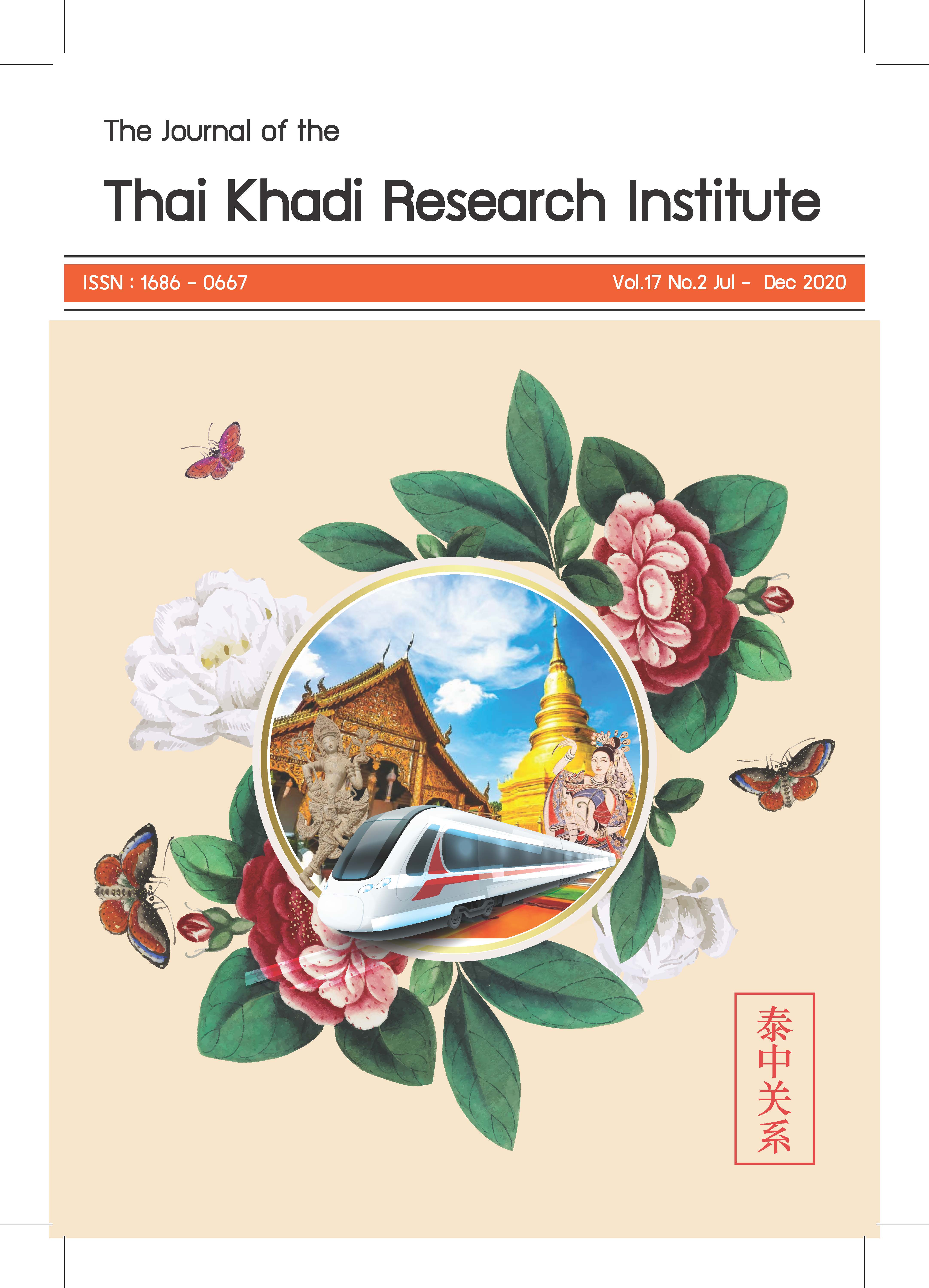มันนิ “ซาไก”: ภาพตัวแทน ชาติพันธุ์ และความเป็นชายขอบ
Main Article Content
บทคัดย่อ
บทความวิจัยนี้มุ่งศึกษาภาพตัวแทนของมันนิ “ซาไก” ที่นำเสนอผ่าน วาทกรรมหนังสือพิมพ์รายวันไทยและวาทกรรมสารคดี ศึกษากลวิธีทางภาษาที่ใช้เพื่อสื่อภาพตัวแทนดังกล่าว และความสัมพันธ์ของภาพตัวแทนมันนิ “ซาไก” กับความเป็นชาติพันธุ์และชายขอบ ข้อมูลที่ศึกษาประกอบด้วยหนังสือพิมพ์รายวันภาษาไทยออนไลน์ 10 ชื่อฉบับ สารคดีมานิ (ซาไก) ที่เป็นสื่ออิเล็กทรอนิกส์เผยแพร่ในรูปแบบวิดีโอทางยูทูป (YouTube) และสื่อสิ่งพิมพ์สารคดีอีก 2 ฉบับ ผลการศึกษาพบว่า ผู้ประกอบสร้างวาทกรรมหนังสือพิมพ์รายวันไทยใช้กลวิธีทางภาษา 3 กลวิธี ได้แก่ การเลือกใช้คำศัพท์ การใช้อุปลักษณ์ และการใช้โครงสร้างประโยคเพื่อสื่อความหมาย ส่วนในวาทกรรมสารคดีผู้ประกอบสร้างใช้กลวิธี 4 กลวิธี ได้แก่ การเลือกใช้คำศัพท์ การใช้อุปลักษณ์ การใช้รูปประโยค และการปฏิเสธ กลวิธีทางภาษาในวาทกรรมหนังสือพิมพ์รายวันไทยใช้เพื่อนำเสนอภาพตัวแทนของซาไก ได้แก่ 1) ซาไกเป็น คนป่าล้าสมัย แตกต่างจากคนส่วนใหญ่ของประเทศ 2) ซาไกเป็นผู้มีชีวิตที่เร่ร่อน 3) ซาไกมีวิถีชีวิตที่เปลี่ยนแปลง 4) ซาไกเป็นผู้ที่ต้องได้รับการช่วยเหลือดูแล แก้ไขปัญหา และพัฒนาคุณภาพชีวิต และ 5) ซาไกเป็นสินค้าของการท่องเที่ยว สำหรับกลวิธีทางภาษาในวาทกรรมสารคดีสื่อให้เห็นภาพตัวแทนของซาไก ได้แก่ 1) ซาไกเป็นผู้มีชีวิตผูกพันกับผืนป่า 2) ซาไกเป็นผู้มีชีวิตที่เร่ร่อน 3) ซาไกมีวิถีชีวิตที่เปลี่ยนแปลง 4) ซาไกเป็นผู้ที่ต้องได้รับการช่วยเหลือดูแล 5) ซาไกเป็นผู้ด้อยโอกาสและถูกเอาเปรียบจากสังคม และ 6) ซาไกเป็นสินค้าของการท่องเที่ยว ทั้งนี้ ภาพตัวแทนของมันนิ ซาไก ยังสัมพันธ์กับความเป็นชาติพันธุ์ และชายขอบ กล่าวคือ มันนิ “ซาไก” เป็นกลุ่มชาติพันธุ์หนึ่งที่ถูกสร้างให้มีนัยหมายถึงความเป็นชนส่วนน้อย ถูกผลักให้ออกห่างไปยังชายขอบ อันเป็นทิศทางที่ตรงกันข้ามกับศูนย์กลางหรือชนส่วนใหญ่ของประเทศ
Downloads
Article Details
ผู้เขียนจะต้องลงนามในแบบฟอร์มรับรองบทความ เพื่อให้คำยืนยันความรับผิดชอบว่า บทความของผู้เขียนนั้นไม่เคยตีพิมพ์ที่ใดมาก่อน พร้อมรับทราบว่า กระบวนการส่งบทความเข้าพิจารณาและตีพิมพ์ในวารสารไทยคดีศึกษานั้น จะไม่มีการเรียกเก็บค่าใช้จ่ายในการดำเนินการ ยกเว้น ในกรณีที่ผู้เขียนขอยกเลิกการตีพิมพ์บทความในวารสารไทยคดีศึกษาไม่ว่าด้วยสาเหตุใด และหลังจากบทความนั้นเข้าสู่กระบวนการพิจารณาของผู้ทรงคุณวุฒิไปแล้ว ผู้เขียนจะต้องรับผิดชอบต่อค่าใช้จ่ายที่เกิดขึ้นในกระบวนการประเมินเป็นจำนวนเงิน 3,000 บาท (สามพันบาทถ้วน)
เอกสารอ้างอิง
Boonyasaranai, P. (2003). Chon phaoʻākhā: phāplak thī thūk sāng hai sokkaprok lālang tǣ dưngdūt čhai [Akha people: an image that is made dirty, lagging but attractive]. Bangkok: Plan Printing.
Brooks, J. (2013). Sā kai [Sakai]. Retrieved February 15, 2015, from https://www.youtube.com.
Charoensin-o-larn, Ch. (1999). Wāt kammakān phatthanā: ʻamnāt khwāmrū khwām čhing ʻēkkalak læ khwāmpen ʻư̄n [Develop- ment Discourse Power Knowledge truth Identity and Otherness]. Bangkok: Research and Development Center, Krirk University.
Choenkwan, Ph. (2006). Kānsư̄sān khō̜ng klum sā kai thī yāi thinthān māsū chumchon mư̄ang nai kān prap tūa læ kān sadǣngʻattalak hǣng chāttiphan [Communication for adaptation and identity presentation of Sakais indigenous immigrating to town community] (Master’s thesis, Chulalongkorn University).
Chulalongkorn University, Bangkok. Suwanit, Pr. (1988). Khrō̜p khrūa sā kai mư̄a khon pā mā yū mư̄ang [Sakai family when the savage came to town]. Sarakadee, 38(4), 52 - 71.
Duangjan, P. (1980). Sā kai: čhao hǣng khun khao læ samunphrai [Sakai: Master of the mountains and herbs]. Bangkok: Office of the National Culture Commission, Ministry of Education.
Hongladarom, Kr. (2000). Parit chēt kīeokap chonklumnō̜i nai prathēt Thai: kānsưksā khwāmsamphan rawāng phāsā kap ʻudomkān [Discourses on ethnic minorities in Thailand: a study of the relationship between form and meaning]. Bangkok: Chulalongkorn University.
Komprasit, M. (2010). Kānsưksā prīapthīap withīkān bō̜k wēlā nai phāsā Thai Krung Thēp kap phāsā sā kai ʻǣn thī ʻamphœ̄ pā bō̜n čhangwat Phatthalung [A comparative study of temporal expressions in Bangkok Thailand Sakai Taenaen at Pa Bon district, Phatthalung province] (Master’s thesis, Silpakorn University).
Kunnuwong, S. (2013). Māni [Mani]. Retrieved February 15, 2015, from https://www.youtube.com.
Luangaram, P. (2003). Attalak chāttiphan læ khwāmpen chāi khō̜p [Ethnic identity and marginalization]. Bangkok: Plan Printing.
Mukdawijitra, Y. (2005). ʻān watthanatham chumchon [Read community culture]. Bangkok: Fah Deaw Kan.
Phakdeephasuk, S. (2018). Khwāmsamphan rawāng phāsā kap ʻattalak læ nǣothāng kānnam māsưksā phāsā Thai [The Relationship between Language and Identity and Ways to Study Thai]. Bangkok: Faculty of Arts, Chulalongkorn University.
Phanchan, Y. (1992). Chīwit dang fan thī thư̄akkhao banthat [Life is like a dream in the Banthat mountain range]. Bangkok: Art literature.
Panpothong, N. (2013). Wāt kam wikhro̜ chœ̄ng wi phāk tām nǣo phāsāsāt [Critical Discourse Analysis based on linguistics]. Bangkok: Faculty of Arts, Chulalongkorn University.
Photčhanānukrom plǣ phāsā [Translate dictionary]. (2015). Retrieved February 26, 2015, from http://th.w3dictionary.org/index.
Phothisan, Ch. (2013). Klum chāttiphan māni (sā kai) kap kān khao sū prachākhom ʻĀsīan [Mani Ethnic Group (Sakai) and the entry into ASEAN]. Nakhon Pathom: Center for the Study of Language and Culture in Crisis Mahidol University.
Raksasat, A. (et al). (2002). Prachāthipatai ʻudomkān lakkān læ bǣpyāng kān pokkhrō̜ng lāi prathēt [Democracy, ideology, principles and precedents of governance of many countries]. Bangkok: Chulalongkorn University Press.
Ritthaphirom, B. (2005). Nāyoknang ngo̜ sē mang phāk tai [Mr. Kanang Ngo Semang, southern region]. Bangkok: Bhannakij.
Silapasan, U, Phraya. (2005). Lak phāsā Thai [Thai language principles]. Bangkok: Thai Watana Panich.
Suriya, Th. (2011). Khwāmsamphan rawāng phāsā kap phāp tūathǣn khō̜ng nakthōt prahān læ kān prahān chīwit nai nangsư̄phim rāi wan Thai [The relationship between language and representations of death - row inmates and executions in Thai newspapers] (Master’s thesis, Silpakorn University).
Winichakul, Th. (2000). Khon ʻư̄n nai phư̄n din ton kāndœ̄nthāng kap kān čhamnǣk chāttiphan khō̜ng rātsadō̜n Sayām tām thin thān rawāng Phō̜.Sō̜. sō̜ngphansīrō̜iyīsippǣt - sō̜ngphansīrō̜i hāsipsām [The Other Within: Travel and Proto - Ethnography in Siam 1880 - 1920]. London: Curgon Press.
Winichakul, Th. (2017). Khon Thai/khon ʻư̄n [Thai people/others]. Nonthaburi: Fah Deaw Kan.


